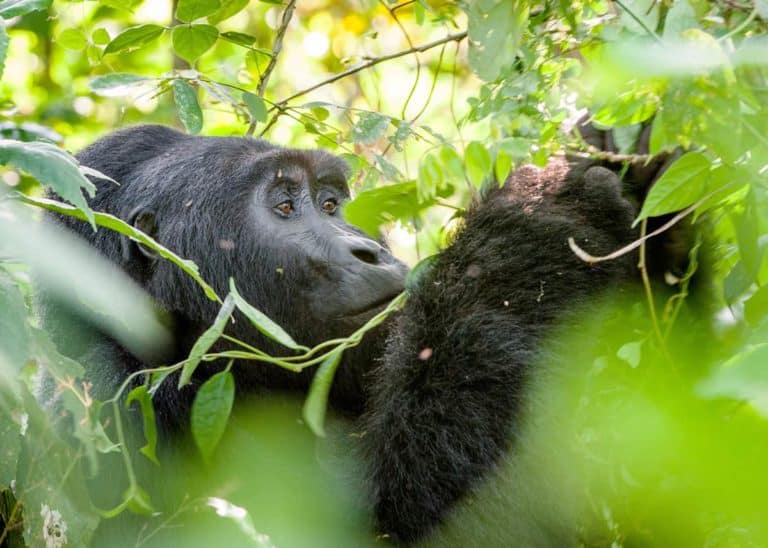14 White Rhinoceros Facts: Southern and Northern (Ceratotherium simum simum)
Curious about the white rhino? In this post, you’ll learn about the differences between northern and southern white rhinoceroses – and between white and black rhinos. You’ll also learn about their population, size, habitat, diet, and recovery efforts.
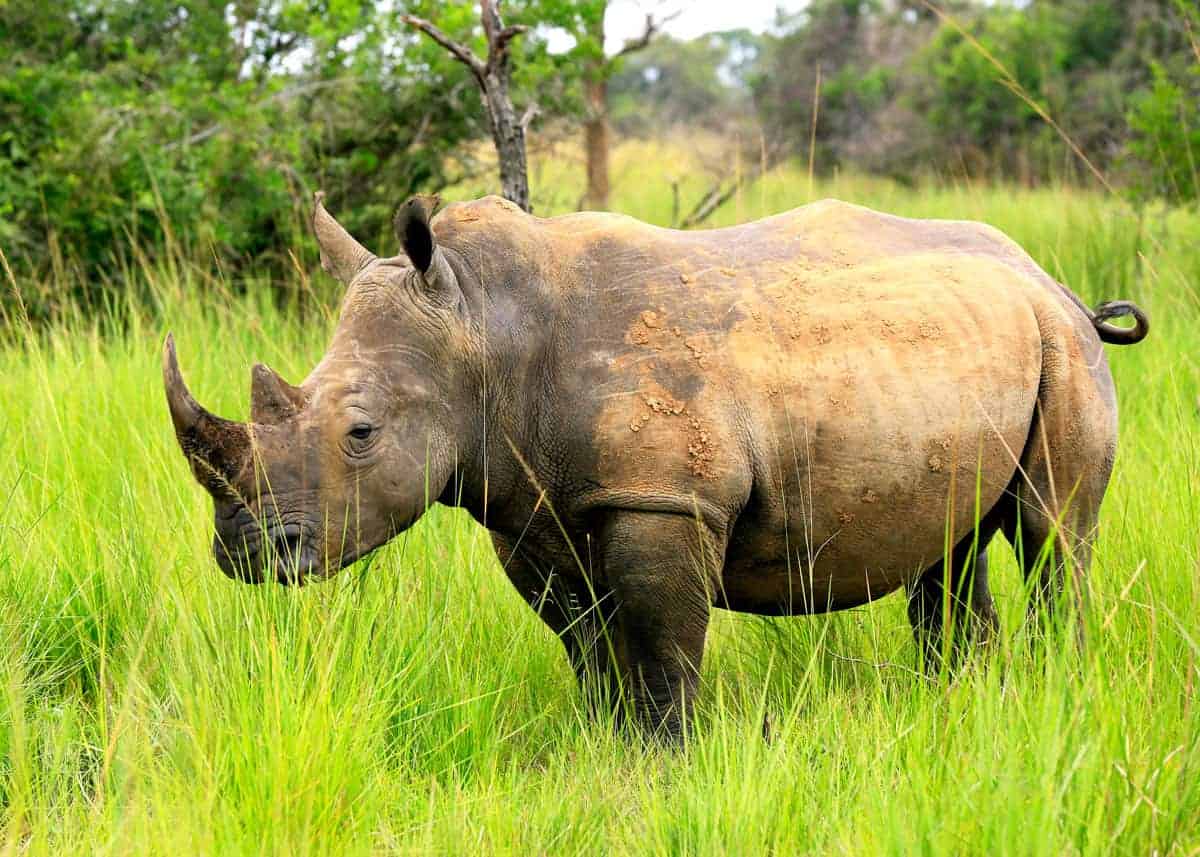
Learn more about other Ugandan animals.
14 White Rhinoceros Facts
The critically endangered white rhinoceros (Ceratotherium simum) population native to Uganda is one of the country’s biggest tourist attractions. While rhinos were once widespread in Uganda, intensive poaching has pushed the species near extinction.
Thankfully, Uganda has adopted a national rhino strategy and a major sanctuary to increase the population of this beautiful animal. If you’re considering visiting Uganda and hope to see the white rhino, here are some interesting facts you should know.
1. There Are Two Sub-Species of White Rhino
There are two subspecies of the white rhinoceros:
- Southern white rhino (Ceratotherium simum simum) It’s estimated that there are about 20,000 wild southern white rhinos today, which makes them the most abundant species of rhino.
- Northern white rhino (Ceratotherium simum cottoni) There are only a few northern white rhinos remaining, all of which are in captivity.
2. White Rhino Population in Uganda is 32
The Ziwa Rhino Sanctuary opened in 2005 in an effort to save the rhino from extinction. Since then, the population has increased to 32 rhinos.
The latest is a male calf born in 2017 to an 18-year-old rhino named Nandi. The sanctuary was started with just six breeding rhinos from Kenya and the United States, two of which were donated by Disney’s Animal Kingdom of Orlando, Florida. The population of white rhinos in Uganda is now 32 individuals. Meet some of them.
Update August 2020: According to Rhino Fund, this number has now increased to 32 individuals. Thanks to Angie Genade, Executive Director of Rhino Fund Uganda for the update.
3. White Rhinos Aren’t White
A common misconception about rhinos is that white rhinos are white and black rhinoceroses are black.
Actually, the word “white” is merely a mispronunciation by English settlers in South Africa of a Dutch word, “wijd,” or wide. The white rhinoceros was described as “wijd” because it has wider lips than the black rhino with its prehensile upper lip. The black rhino gets its name because it’s usually seen covered in mud.
Both white and black rhinos are grey.
4. 8 Differences Between Black and White Rhino
- Size: The white rhino is substantially larger, with a female white rhino weighing about 1,700 kg (males about 2,300 kg) compared to black rhinos that range from 800 – 1,400 kg.
- Mouth and Diet: The most significant difference between white and black rhinos is found in their mouths. White rhinos (square-lipped rhinoceros) have a wide, broad lip – perfect for grazing. In contrast, the black rhino (also known as hook-lipped rhinoceros) feeds on leaves and shoots and has a prehensile, pointed lip perfect for grabbing hold of food on plants and bushes.
- Subspecies: White rhinos have two subspecies (northern and southern). Black rhinos are divided into eight subspecies.
- Ears: White rhinos have notoriously poor eyesight. As a result, it has long, tubular ears that swivel independently. This is important because it frequently has its head down while grazing. Because the black rhino feeds with its head up most of the time, it is less dependent on just one sense – its ears are smaller and rounder.
- Horn: Typically, the white rhino has a much longer front horn and a very small second horn. The black rhino’s horns are much more similar in length.
- Habitat: Because of their differing diets, each species have unique habitats. White rhinos are usually found on open grasslands while black rhinos are usually found in amongst brush and thickets – with their food source.
- Behavior: Black rhinos are known for being more curious and more aggressive. Because of their poor eyesight, white rhinos are likely to run from an encounter rather than attack. But they will still attack – caution is needed with both species.
- Dung: Because of their differing diets, their dung is easily distinguishable. White rhino dung is badly digested and will look like clumps of grass cut with a lawnmower. In contrast, black rhino dung contains sticks and twigs.
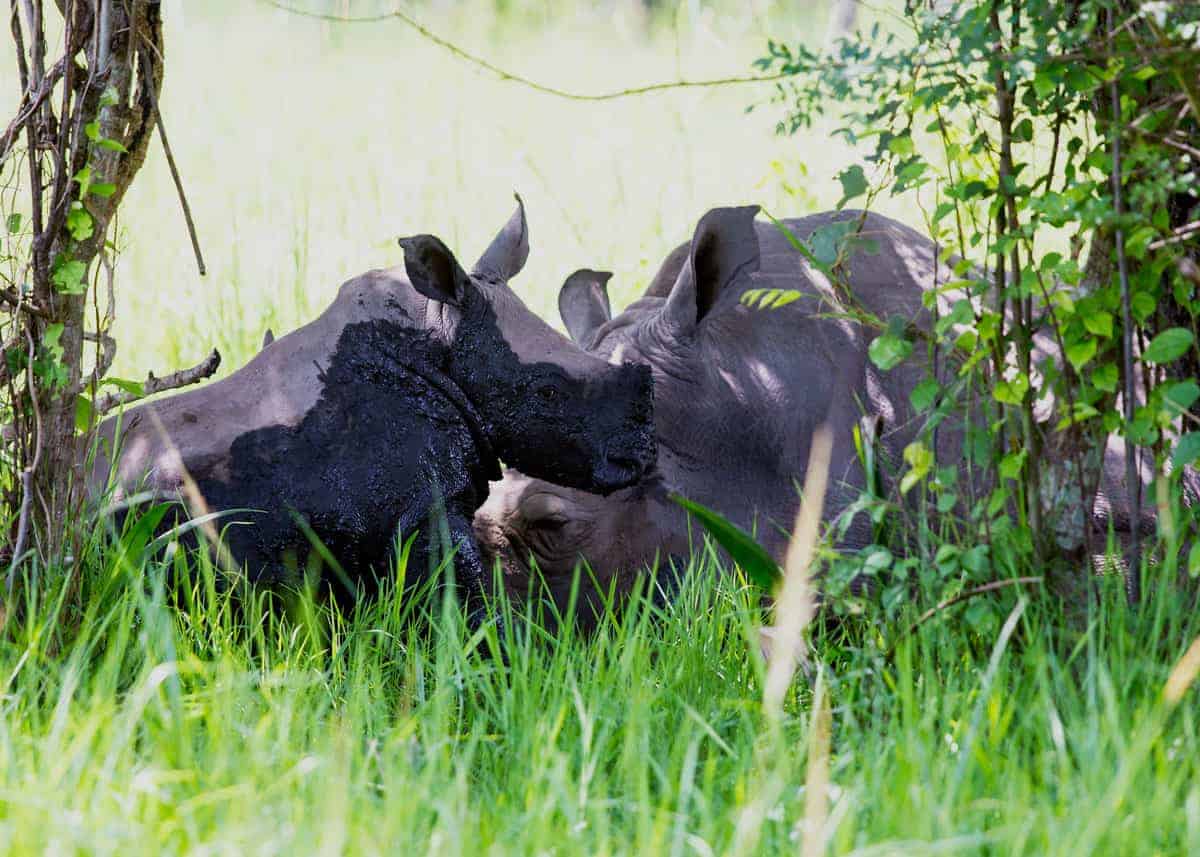
5. The Ziwa Rhino Sanctuary Takes Protection Seriously
Nearly all white rhinos in Uganda are located in the Ziwa Rhino Sanctuary, which is under the authority of the Uganda Wildlife Authority. The organization takes many steps to ensure the rhino population is safe from poachers who hope to sell the animal’s horn.
The goal of the sanctuary is to provide a secure environment to expand the rhino population through breeding. The rhinos will then be slowly reintroduced to national parks in Uganda.
The sanctuary features three electric fences to separate the 7,000-hectare sanctuary from the surrounding land. A fourth boundary is a swamp. The sanctuary is staffed by security guards and rangers who watch the rhinos 24 hours daily.
In 2015, all rhinos at the Ziwa Rhino Sanctuary went through an operation to implant microchips beneath their skin and in their horns. These microchips will help stop rhino poaching and end the illegal horn trade in Uganda by offering undeniable proof that a horn recovered from smugglers came from one of the animals. With this evidence, poachers, smugglers, and traders can be convicted in court.
6. Most Rhinos Live in Southern Africa
Most southern white rhinos are located in Southern Africa but there are reintroduced populations in Swaziland, Namibia, Botswana, Zimbabwe, and Uganda. The northern white rhino was once found in areas like northwest Uganda, southwest Sudan, northeast DRC, and southern Chad as this sub-species prefers savanna woodlands and grasslands.
A survey in 2005 by African Parks Foundation and the African Rhino Specialist Group found just 4 northern white rhinos in the wild: a group with 2 females and one male and a solitary male. By 2008, it was reported the sub-species was extinct in the wild. The last four members of the white northern rhino were killed by poachers.
“The last four northern white rhinoceros remaining in the wild are feared to have been killed for their horns by poachers and are now believed to be extinct in the wild. Only a few are left in captivity but they are difficult to breed and the number is so low that the species is regarded as biologically unviable.
The northern white rhino, Ceratotherium simum cottoni, has been struggling for suvival [sic] since the 1970s, when numbers dropped from about 500 to 15. A slight recovery was recorded in 2003 when 30 were counted but by 2006 only four were left. All of them were recorded in the Garamba National Park in the Democratic Republic of Congo but war and civil unrest in the region has led to an increase in poachers.”
WebArchive.org / The Times
7. White Rhinos Are Very Social
While all rhinos are social, this is especially true with white rhinos. All white rhinos live in herds (or crashes) of up to 14. These herds are mostly made up of females.
Younger males congregate with an adult female, while adult bulls live alone.
8. White Rhinos Are the Largest Rhino Species
The white rhinoceros is the largest of the five rhino species weighing a bit more than a hippopotamus. The white rhino is known for its short neck and broad chest. Males can be up to 5 meters (13 feet) long while females can reach 3.6 meters (12 feet) long, not including the tail. When standing, the rhino is about 6 feet tall.
Males tend to be heavier at 2,300 kg (5,070 pounds) compared to 1,700 kg (3,750 pounds) with females.
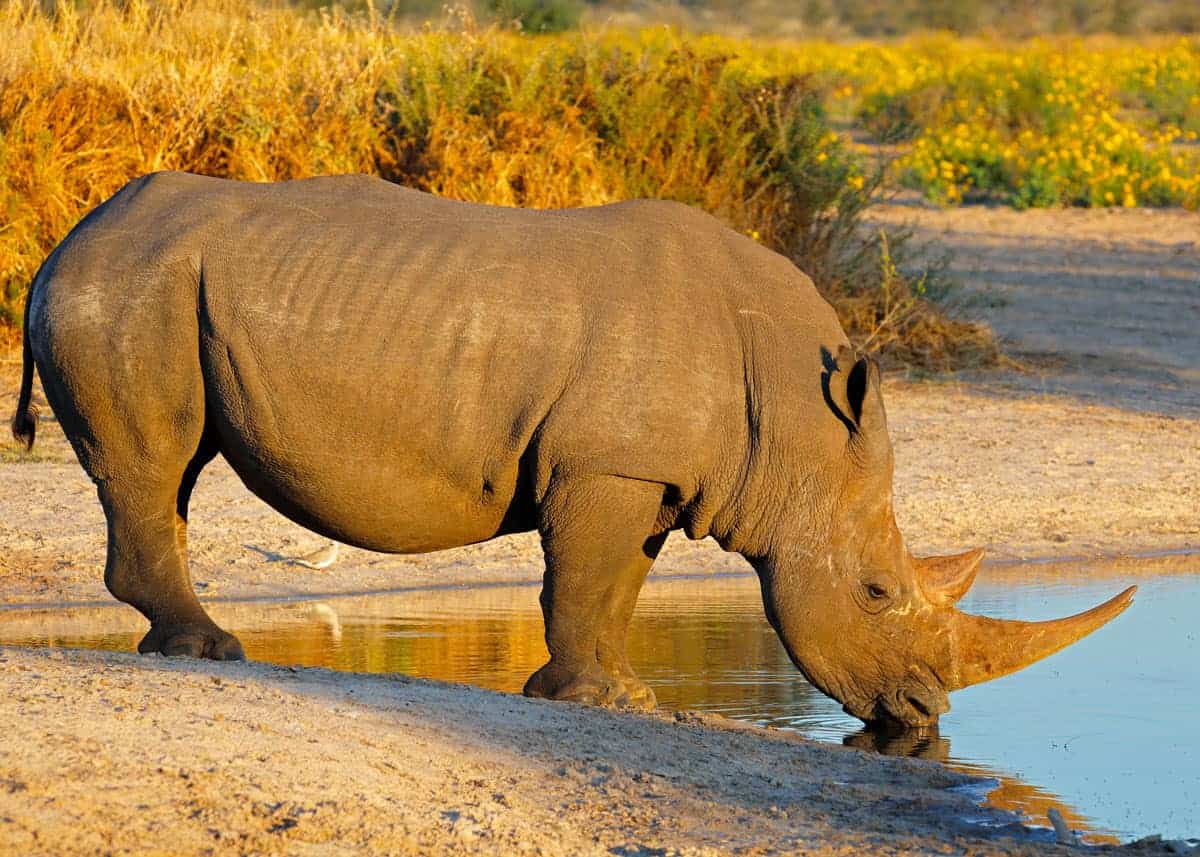
How’s your Swahili? Check out our guide to 100+ animal names in Swahili.
9. Humans Are the Only Threat to White Rhinos
An adult white rhino has no natural predators given their size, horns, and thick skin, although humans have been a major threat.
Poaching has threatened rhino populations for more than 400 years, although the rise of sport hunting in the 19th century nearly drove the white rhinos to extinction. Anti-poaching laws in Nepal and India helped with remaining white rhinos relocated to reserves.
Despite absolutely no scientific evidence, rhino horns have long been prized for their use in traditional Asian medicine. It’s claimed that powdered rhino horn can cure a variety of health problems.
This demand has led organized international poaching syndicates to carry out missions that even use advanced technology like night vision scopes and helicopters. Today, much of the demand comes from Thailand and China. A white rhino horn can sell for up to $3,000 on the black market in South Africa.
Before the 1800’s, South Africa was home to hundreds of thousands of rhinos. Today, it is home to 70% of just 29,000 remaining on earth.
10. A Rhino’s Horn Can Grow Back
Rhino horns are not made of bone like cattle. Their horns are made from keratin, the same protein that makes up human fingernails and hair.
While poachers have nearly driven rhinos to extinction to kill them for their horns, rhino horns can actually be trimmed off safely and grow back without harming the animal, much like trimming fingernails.
In fact, South African rhino farmers do just that. Every year or so, farmers tranquilize the animals, cut off up to 4 pounds of horn from every rhino, and store it in a vault in hopes that it will be legal to sell one day.
11. Rhinos Can’t See Well
White rhinos have very poor eyesight which may be one reason they sometimes charge for no apparent reason. To make up for this, the white rhinoceros has excellent hearing and smell. A rhino’s retina should be able to detect and recognize a human form at about 200 meters.
12. A White Rhino Can Reach 50 Years Old
Rhinos can have a very long life and a long gestation period. A pregnant rhino carries her child for 16 months or about 450 days. This is the second-longest gestation period of all animals after the elephant.
A female will reach sexual maturity at 7 while males reach maturity at 11. During courtship, a male will call out when approaching a female in his territory and block her path while squealing.
When a white rhino calf is born, it’s usually 40 to 65 kg (88-143 lbs). Calves will be unsteady for the first few days but enjoy the fierce protection of their mothers.
While a mother rhino will start weaning its calf around 2 months, many rhinos nurse for up to a year. Female rhinos reproduce every 2 to 5 years and chase off a current calf before giving birth to the next. The calf will likely never meet its father.
Rhinos have a fairly long life of up to 50 years, although this depends on their habitat and poaching. Rhinos in captivity typically reach this lifespan.
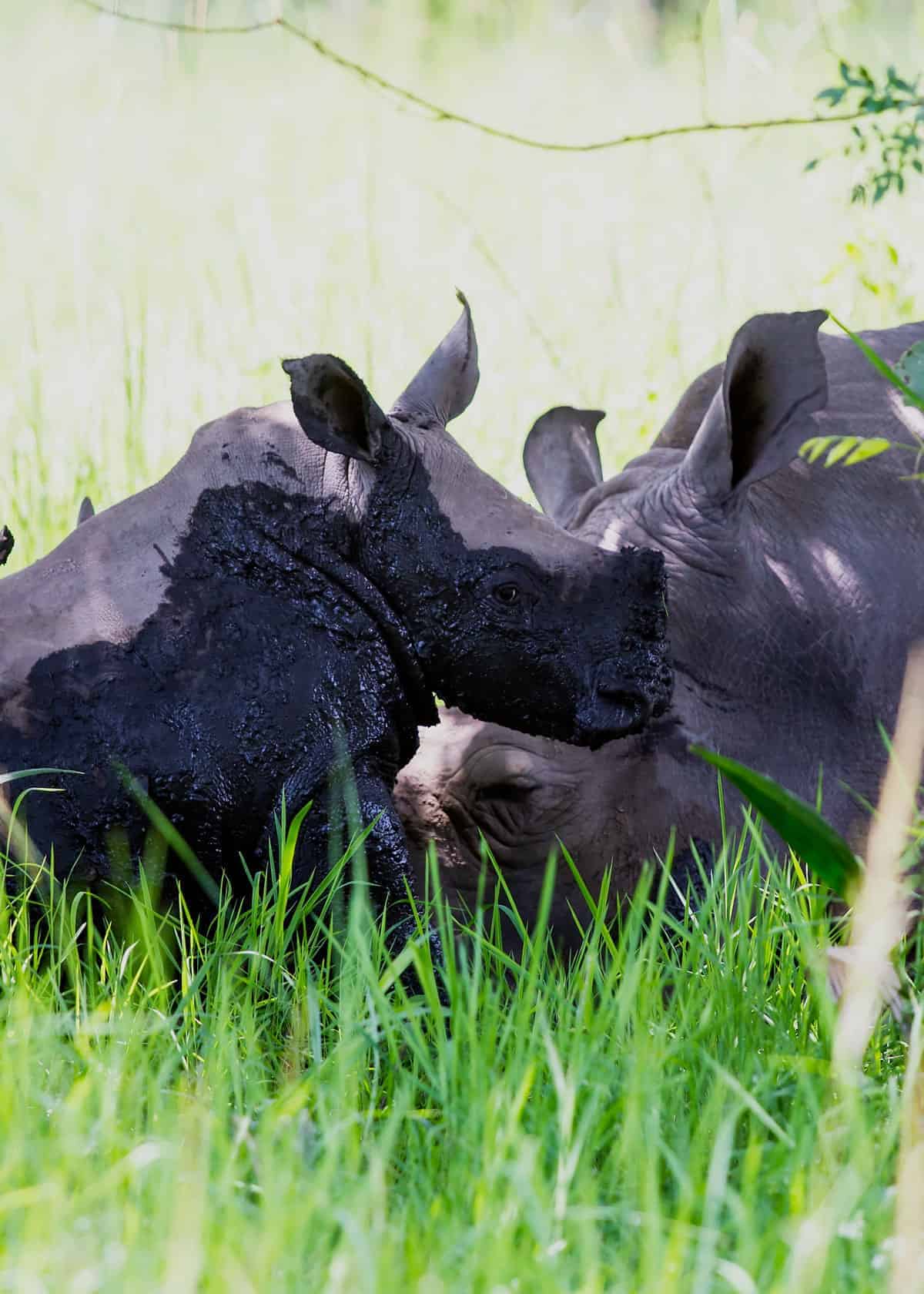
Keep reading: How fast can a rhino run?
13. White Rhinos Are Fearsome Herbivores
Despite its large size and dangerous horns, the white rhinoceros is an herbivore. White rhinoceroses enjoy living in open savanna and grassland. The white rhino is one of the largest pure grazers on earth, eating nothing but grass, especially short grains.
When available, a rhino will drink twice a day but can go up to five days without water during drought. The white rhinoceros must eat up to 120 pounds of grass daily. This usually means almost non-stop eating to support its large size. Because the rhino has no natural predators, it tends to eat slowly without fear.
The black rhino, in comparison, eats a wide variety of plant life, including leaves and fruits. Black rhinos eat about 200 plant species in the wild.
This massive amount of food comes at a stinky price. An adult white rhinoceros can produce up to 50 pounds of dung every single day.
14. The Rhino is Related to the Woolly Mammoth
The modern rhinoceros is related to the woolly mammoth that lived during the ice age. During this time, a species called the woolly rhinoceros lived alongside woolly mammoths. These rhinos are believed to have had the largest range of any rhino species that has ever lived. The woolly rhino, which went extinct 10,000 years ago, was also an herbivore that grazed on lichen and grass.
Interestingly, a fossilized skull found in a city in southern Austria around 1500 was believed to be that of a dragon. A statue was built of a large dragon with bat-like wings and a body like a crocodile. Sculptures used the skull they found as the model for the statue. Recent testing determined that the skull actually belonged to a woolly rhinoceros.
Closely related to the white rhinoceroses today are zebras, horses, and tapirs — not elephants.
Learn more about rhinos: What Do Rhinos Eat? Guide to All 5 Species
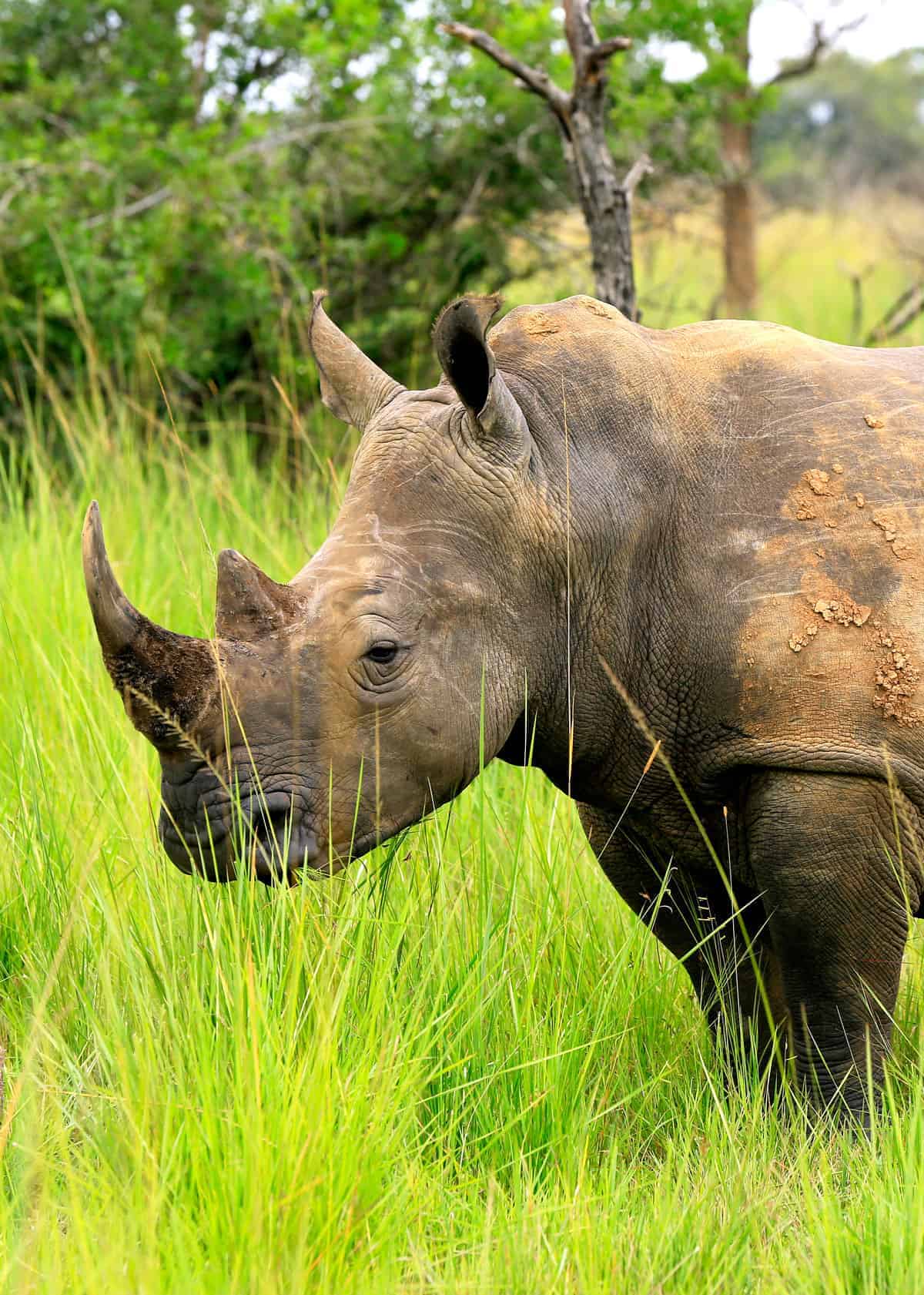
Learn more about Uganda’s mountain gorillas.
Your Turn
What’s your favorite white rhino fact? Have a question about white rhinoceroses? Join us in the comments!






